TL;DPR. As in: Too Long; Didn’t Proof-Read.
Sorry about what I’m sure are many typos and gramerrors.
One of the “problems” with our current roster of space ships and space stations is that they’re built to be as light as possible due to the extreme per-kilogram cost of lifting things into orbit and beyond. You can practically punch your way out the side of the International Space Station, and the entire space station, three hundred and sixty feet long (the length of an NFL football field), two hundred and forty feet wide, and almost seventy feet tall only weights as much as 280 of my truck (which is not particularly heavy at 1,600kg) even though you could park over seven hundred of them in its shadow. I know I’m being a little loose with my comparison because it’s not a solid mass and much of that space is solar panels, but point is, it’s built as light as we could get away with building it. I don’t know about you, but if I’m going to spend time in a kill-you-real-quick environment as hostile as outer space, to say nothing of bombardment of micrometeorites, I’d rather be in something built like a tank or a U-boat than something built like a tin-foil pie plate.
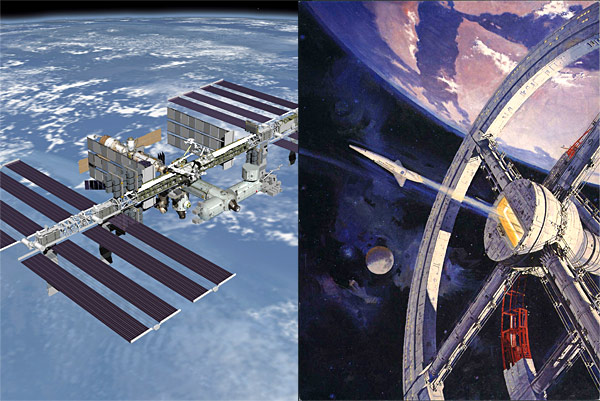
What we have versus what we should have?
As I’m sure you know, the ISS was built in orbit, which arguably increased the complexity and risk and cost of construction. This is because, as the ESA website points out the obvious, we don’t have a launch vehicle big enough to lift its entire 450 ton mass into space in a single launch. Almost exclusively we used the Space Shuttle, which can could lift an admirable 24,000kg to low earth orbit at a go. So far it has taken 31 separate launches with more scheduled. While the official cost to date of the ISS is $150 billion, with 27 Shuttle launches, 2 Proton, and 2 Soyuz launches, I’d ballpark that the cost of the launches alone — not including the cost of developing the launch vehicles (for context a Space Shuttle costs) — was probably somewhere in the realm of $12 billion dollars. For context that’s less than a month of Iraq war spending, and the cost of building the Space Shuttle Endeavor was $1.7 billion, or about 80% of the cost of a B-2 Stealth Bomber. When you look at it that way it didn’t really cost a whole lot. That said, as long as it is a logistical nightmare to lift stuff into space, it’s dubious whether we’re really ever going to do anything all that exciting, at least until there’s a commercial interest.
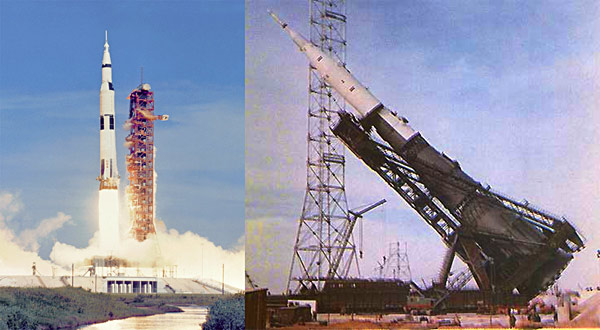
Flying skyscrapers… These things are about 350 feet tall!
The biggest heavy launch vehicle we ever built was the Saturn V rocket that lifted the Apollo missions (above left). The Saturn V was able to lift an incredible 120,000kg into LEO at a cost of $185 million in 1965, or $1.1 billion in 2012 dollars. Using the Saturn V we could have lifted the ISS (and then some) in just four launches — or four and a half billion dollars, about a third the cost of the “modern” systems we used. We have had much larger launch vehicles on the drawing board, but for largely political reasons — it certainly wasn’t technical reasons — they never ended up happening. To understand why, peek over at the Soviet space program of the sixties. They also had a moon shot, and a lot of people thought that they were going to beat America there because of their many space firsts — first ICBM, first satellite, first animal in orbit (and later the first ones to return alive), first telemetry from space, first moon probe, first images of the far side of the moon, first person in space, first Venus probe, first EVA, first lunar orbit, first space docking, and so on, and all of that happened before the Americans got to the moon. In some ways their moon program was smaller and less ambitious than the American one — it was certainly much lighter, which meant a less impressive rocket was needed — but this was mostly because of the fact that their main focus was Mars. They didn’t end up going with the smaller rocket that their moon proram needed, but instead worked on a rocket similar to the Saturn V called the N1 (above right), initially sized in 1959 to be large enough to carry their TMK-1 manned Mars mission (which also included a flyby of Venus on the way home) scheduled for 1971. Unfortunately after the Soviets exploded four N1s (one of the explosions still stands as the biggest non-nuclear kaboom we’ve ever created), they never made it to the moon let alone Mars. As a result, the space race lost a lot of its steam and the Americans stopped going to the moon, canned their own Mars program, and a million geek hears broke.
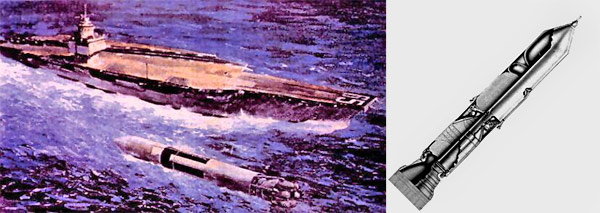
Because the Americans kicked the ambition out of their space program and decided to invest in the Vietnam war instead, they closed down NASA’s Future Projects Branch which was developing a number of heavy launch vehicles intended for the Mars program. The one that is most exciting to me is a gigantic rocket called the “Sea Dragon” (above) because it also seems the most realistic, both for back then and for what should be dusted off today. The Sea Dragon is an interesting rocket not just because it’s incredibly powerful, capable of lifting 550 tons into LEO — that is, the entire current International Space Station plus another hundred tons for good measure — but also because it’s wildly inexpensive. TRW estimated numbers as low as $59 a pound — compare that to about $750 a kilogram in the dollars of the day for the Saturn V. The reason it was so cheap is that a significant percentage of the cost of a rocket is that it’s a highly complex piece of advanced engineering using advanced materials built to precise tolerances and expensive fuels. And then gets wrecked after launch. Also, the costs are such that the raw materials are only about 2% of the final cost, so the price difference between rockets of different sizes is much less than intuition would suggest. So the Sea Dragon was built with the philosophy that it should be as big and as low tech as possible. The whole thing was just a giant steel sheet metal tube 550 feet long. It had one gigantic engine fueled by liquid oxygen and liquid hydrogen (which also meant that it was clean, producing only steam as exhaust) and forced through the system by compressed nitrogen (ie. compressed air basically). The rocket was water launched, and the fuel — oxygen and hydrogen — was produced on site by splitting water into its component hydrogen and oxygen. The plan at the time was to do this with electricity supplied by a nuclear aircraft carrier, but if we were going to resurrect the idea in modern times, I’m sure we would just use wind generators. Sad that this isn’t going on. What a different world we might live in if we could inexpensively lift space stations and moon bases in a single launch. But I suppose we have wars to pay for.
Gawd damn. I hate thinking about the trillion dollar price-tag on the Iraq war. We could have colonized both the moon and Mars for those dollars. I mean, what makes more sense? Killing a bunch of Arabs? Or having thriving human civilizations on three worlds? I know, I know… it’s killing Arabs, right?
They are Muslims after all!
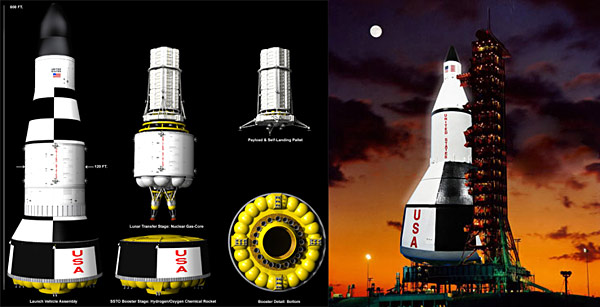
There are so many interesting launch vehicles I could go on about — there’s a nice list, including some speculative and fictional ones, here on the Atomic Rockets Surface-to-Orbit site. I love reading about crazy mega-rockets like Nexus (above picture includes a model) that could lift 900 tons in “normal” mode or almost 5,000 tons when spewing nuclear pollution. Dream big, dream dirty. I love the quote (from the first link in this paragraph) about the Aldebaran launch vehicle that was supposed to be able to lift 60 million pounds — “water take off and landing because there isn’t a runway in the world that could survive that monster.” Ah, back in the days when engineers when men.
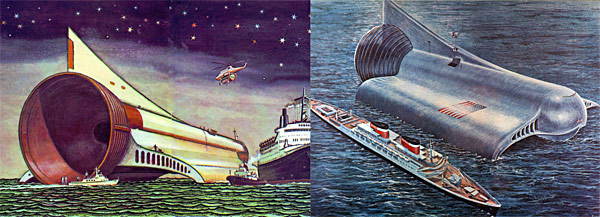
Now, $60 a pound is pretty impressive, but it’s not the best we can do. That would be Project Orion. We did the on-paper and early testing (including accidentally) for this nuclear pulse launch system that was capable of much, much heavier weights for a much lower cost, but again for political reasons (very different ones this time) it was scrubbed. What I’m about to write is not a typo. We are talking launch systems capable of lifting as much as 4,880,000,000kg… Yes, five billion kilograms into orbit and for well under a dollar a kilogram. Even the “small” versions, which were about the same size physically as the Saturn V rocket were capable of tossing 1,600,000kg into orbit, or 1,200,00kg to the moon, or 800,000kg all the way to Mars with enough fuel left over to get back in a single go. That’s unheard of. It basically means that in a single launch you could throw twenty of the largest cruise ships in the world to the moon. I’ll admit that the way it does it is a little problematically. Your cargo sits on a platform, which sites on top of immense shock absorbers, which sits on top of a giant pusher plate, under which five hundred to a thousand nuclear bombs are detonated in rapid sequence (given the size of our nuclear arsenal, you could argue that using up the fuel instead of letting it rot makes a lot of sense — sure makes more sense than the intended purpose). I have to repeat that this is not theoretical — Freeman Dyson, who headed the project, got it to the testing phase, which you can read about in a great book written by his son or watch in “To Mars by A-Bomb (The Secret History of Project Orion)” that I just noticed some SOPA-antagonizer has uploaded to YouTube and all sorts of other direct-download sites. Highly recommended.
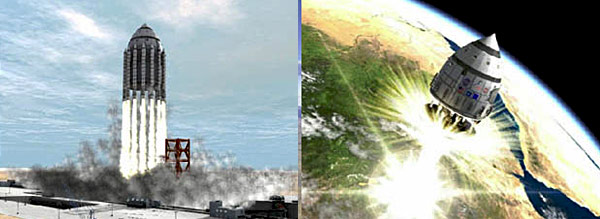
(Those pictures are from DRB’s coverage of Orion.)
Anyway, the short version as to the politics of it all surrounds the fact that it was nuclear bomb powered, which came with three big problems. First of all, it made it a military venture. Second of all, it made it highly classified, and made doing the required research on clean nukes and so on extremely difficult to sell to politicians. This was compounded by the fact that America’s space program had been put under the largely public civilian agency NASA. And finally, when America signed off on the Partial Test Ban in 1963 stopping above-ground nuclear detonations, it effectively shut down the program. There was a brief period in the fifties where America was debating whether to go with chemical rockets or nuclear rockets, and I have to wonder what space would look like if weight requirements were simply a non-issue. What would it be like if we could launch a small city in a single shot? If we could dump whole collections of factories on the any moon or planet in our solar system. And don’t get me started on the interstellar possibilities — Project Daedalus, a mission to Barnard’s Star, was based on similar technology, and Dyson considered a trip to Alpha Centauri since Orion could potentially get there in less than fifty years. It’s both inspiring and heartbreaking.
I will mention that we have actually recently dusted off the nuclear pulse technology because it’s the only thing we have that could push an extinction-level sized asteroid out of an impact path.
Up above I said that nothing interesting would happen in space until there’s a commercial imperative, and that wasn’t just a throwaway sentence. Multiple big mining companies are now seriously eyeballing both the moon and the asteroids. On one hand that sounds nutty, but on the other hand, mining already costs a small fortune. A big oil rig costs a half billion dollars, which is way less than Space Adventures private moon flyby mission is costing them. Big mining equipment costs a fortune — $150 million plus for some of the big excavators and draglines — and billions are spent on exploration alone, let alone the many, many trillions spent on mineral extraction itself. The dollars spent on mining right now dwarf the Apollo program’s cost. Hell, they dwarf the amount of money spent by every nation on space, ever. NASA and others are currently putting more and more serious feelers out to determine the exact mining value of the moon, but as soon as we can make a solid gamble at it, be it for precious metals, rare elements, or even Helium3 once we figure out fusion, there will be dozens of mega-corporations scrambling to loot the moon. And then it snowballs. In many ways — to say nothing of environmental issues — mining the moon and the asteroids is less problematic than mining the ocean. And all we have to do is get a couple mining operations up there, with factories and processing facilities, and boom, all of a sudden we have colonized the moon. Even if we never build a modern Sea Dragon or Orion, and we have PayPal fly up the first factories bit by bit in their new Falcon heavy-lift rockets, after a short while we won’t have to carry stuff up there — we can just build it with the moon’s own resources. And then maybe moon mining will discover arcologies from the past, right? Now that would be exciting.
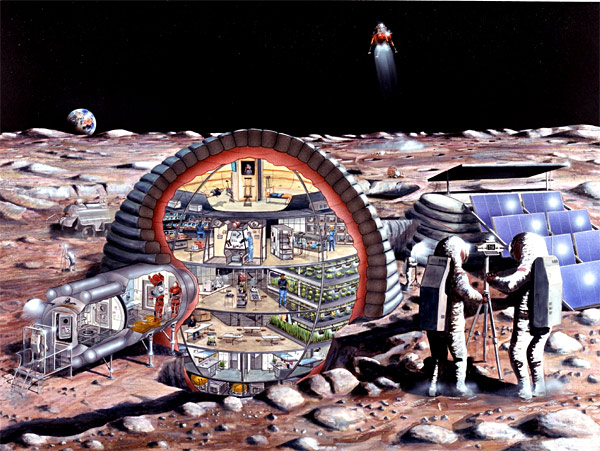
That picture is completely UN-ambitious. Fail.
It’s gonna happen and it’s gonna happen soon. Stuff like this makes me really wish I was going to live longer and really excited about the kind of world my daughter is going to get to be a part of. World? I spoke wrong. The kind of worlds she’s going to get to be a part of.
Worlds. I like that.



2 Comments
yes
Are you aware of the Copenhagen Suborbitals project? (https://www.copenhagensuborbitals.com/) Basically, it’s a group of friends who are working out of a warehouse in a shipyard, making a private, sea-launched manned spaceflight. They are well along in the process, and have conducted a number of successful (and not so successful) test flights (unmanned).
Their FB page today had a comment on the economics of DIY spaceflight that tracks fairly precisely with some of your numbers (www.facebook.com/CopenhagenSuborbitals?sk=wall)
We do live in exciting times. Dream on.
One Trackback/Pingback
[...] the beginning of commercial asteroid mining, which I have to admit is very exciting. In one of my recent rocketry posts I mentioned that a few major mining corporations are realizing that mining the moon is starting to [...]
Post a Comment